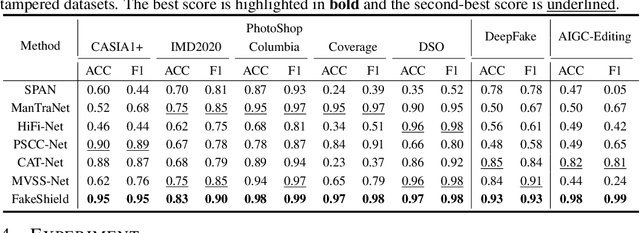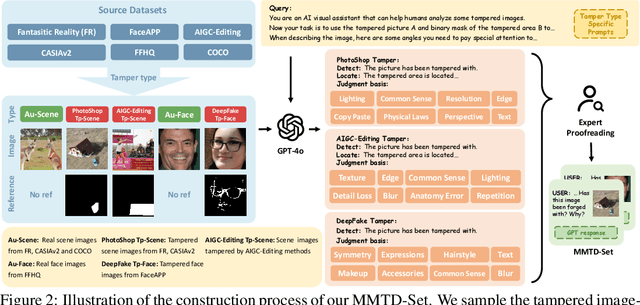Qing Huang
FinanceReasoning: Benchmarking Financial Numerical Reasoning More Credible, Comprehensive and Challenging
Jun 06, 2025Abstract:We introduce FinanceReasoning, a novel benchmark designed to evaluate the reasoning capabilities of large reasoning models (LRMs) in financial numerical reasoning problems. Compared to existing benchmarks, our work provides three key advancements. (1) Credibility: We update 15.6% of the questions from four public datasets, annotating 908 new questions with detailed Python solutions and rigorously refining evaluation standards. This enables an accurate assessment of the reasoning improvements of LRMs. (2) Comprehensiveness: FinanceReasoning covers 67.8% of financial concepts and formulas, significantly surpassing existing datasets. Additionally, we construct 3,133 Python-formatted functions, which enhances LRMs' financial reasoning capabilities through refined knowledge (e.g., 83.2% $\rightarrow$ 91.6% for GPT-4o). (3) Challenge: Models are required to apply multiple financial formulas for precise numerical reasoning on 238 Hard problems. The best-performing model (i.e., OpenAI o1 with PoT) achieves 89.1% accuracy, yet LRMs still face challenges in numerical precision. We demonstrate that combining Reasoner and Programmer models can effectively enhance LRMs' performance (e.g., 83.2% $\rightarrow$ 87.8% for DeepSeek-R1). Our work paves the way for future research on evaluating and improving LRMs in domain-specific complex reasoning tasks.
LMCD: Language Models are Zeroshot Cognitive Diagnosis Learners
May 27, 2025Abstract:Cognitive Diagnosis (CD) has become a critical task in AI-empowered education, supporting personalized learning by accurately assessing students' cognitive states. However, traditional CD models often struggle in cold-start scenarios due to the lack of student-exercise interaction data. Recent NLP-based approaches leveraging pre-trained language models (PLMs) have shown promise by utilizing textual features but fail to fully bridge the gap between semantic understanding and cognitive profiling. In this work, we propose Language Models as Zeroshot Cognitive Diagnosis Learners (LMCD), a novel framework designed to handle cold-start challenges by harnessing large language models (LLMs). LMCD operates via two primary phases: (1) Knowledge Diffusion, where LLMs generate enriched contents of exercises and knowledge concepts (KCs), establishing stronger semantic links; and (2) Semantic-Cognitive Fusion, where LLMs employ causal attention mechanisms to integrate textual information and student cognitive states, creating comprehensive profiles for both students and exercises. These representations are efficiently trained with off-the-shelf CD models. Experiments on two real-world datasets demonstrate that LMCD significantly outperforms state-of-the-art methods in both exercise-cold and domain-cold settings. The code is publicly available at https://github.com/TAL-auroraX/LMCD
MARS: Defending Unmanned Aerial Vehicles From Attacks on Inertial Sensors with Model-based Anomaly Detection and Recovery
May 02, 2025Abstract:Unmanned Aerial Vehicles (UAVs) rely on measurements from Inertial Measurement Units (IMUs) to maintain stable flight. However, IMUs are susceptible to physical attacks, including acoustic resonant and electromagnetic interference attacks, resulting in immediate UAV crashes. Consequently, we introduce a Model-based Anomaly detection and Recovery System (MARS) that enables UAVs to quickly detect adversarial attacks on inertial sensors and achieve dynamic flight recovery. MARS features an attack-resilient state estimator based on the Extended Kalman Filter, which incorporates position, velocity, heading, and rotor speed measurements to reconstruct accurate attitude and angular velocity information for UAV control. Moreover, a statistical anomaly detection system monitors IMU sensor data, raising a system-level alert if an attack is detected. Upon receiving the alert, a multi-stage dynamic flight recovery strategy suspends the ongoing mission, stabilizes the drone in a hovering condition, and then resumes tasks under the resilient control. Experimental results in PX4 software-in-the-loop environments as well as real-world MARS-PX4 autopilot-equipped drones demonstrate the superiority of our approach over existing IMU-defense frameworks, showcasing the ability of the UAVs to survive attacks and complete the missions.
Explore-Construct-Filter: An Automated Framework for Rich and Reliable API Knowledge Graph Construction
Feb 19, 2025Abstract:The API Knowledge Graph (API KG) is a structured network that models API entities and their relations, providing essential semantic insights for tasks such as API recommendation, code generation, and API misuse detection. However, constructing a knowledge-rich and reliable API KG presents several challenges. Existing schema-based methods rely heavily on manual annotations to design KG schemas, leading to excessive manual overhead. On the other hand, schema-free methods, due to the lack of schema guidance, are prone to introducing noise, reducing the KG's reliability. To address these issues, we propose the Explore-Construct-Filter framework, an automated approach for API KG construction based on large language models (LLMs). This framework consists of three key modules: 1) KG exploration: LLMs simulate the workflow of annotators to automatically design a schema with comprehensive type triples, minimizing human intervention; 2) KG construction: Guided by the schema, LLMs extract instance triples to construct a rich yet unreliable API KG; 3) KG filtering: Removing invalid type triples and suspicious instance triples to construct a rich and reliable API KG. Experimental results demonstrate that our method surpasses the state-of-the-art method, achieving a 25.2% improvement in F1 score. Moreover, the Explore-Construct-Filter framework proves effective, with the KG exploration module increasing KG richness by 133.6% and the KG filtering module improving reliability by 26.6%. Finally, cross-model experiments confirm the generalizability of our framework.
From Exploration to Revelation: Detecting Dark Patterns in Mobile Apps
Nov 27, 2024Abstract:Mobile apps are essential in daily life, yet they often employ dark patterns, such as visual tricks to highlight certain options or linguistic tactics to nag users into making purchases, to manipulate user behavior. Current research mainly uses manual methods to detect dark patterns, a process that is time-consuming and struggles to keep pace with continually updating and emerging apps. While some studies targeted at automated detection, they are constrained to static patterns and still necessitate manual app exploration. To bridge these gaps, we present AppRay, an innovative system that seamlessly blends task-oriented app exploration with automated dark pattern detection, reducing manual efforts. Our approach consists of two steps: First, we harness the commonsense knowledge of large language models for targeted app exploration, supplemented by traditional random exploration to capture a broader range of UI states. Second, we developed a static and dynamic dark pattern detector powered by a contrastive learning-based multi-label classifier and a rule-based refiner to perform detection. We contributed two datasets, AppRay-Dark and AppRay-Light, with 2,185 unique deceptive patterns (including 149 dynamic instances) across 18 types from 876 UIs and 871 benign UIs. These datasets cover both static and dynamic dark patterns while preserving UI relationships. Experimental results confirm that AppRay can efficiently explore the app and identify a wide range of dark patterns with great performance.
DBF-Net: A Dual-Branch Network with Feature Fusion for Ultrasound Image Segmentation
Nov 17, 2024Abstract:Accurately segmenting lesions in ultrasound images is challenging due to the difficulty in distinguishing boundaries between lesions and surrounding tissues. While deep learning has improved segmentation accuracy, there is limited focus on boundary quality and its relationship with body structures. To address this, we introduce UBBS-Net, a dual-branch deep neural network that learns the relationship between body and boundary for improved segmentation. We also propose a feature fusion module to integrate body and boundary information. Evaluated on three public datasets, UBBS-Net outperforms existing methods, achieving Dice Similarity Coefficients of 81.05% for breast cancer, 76.41% for brachial plexus nerves, and 87.75% for infantile hemangioma segmentation. Our results demonstrate the effectiveness of UBBS-Net for ultrasound image segmentation. The code is available at https://github.com/apple1986/DBF-Net.
FakeShield: Explainable Image Forgery Detection and Localization via Multi-modal Large Language Models
Oct 03, 2024



Abstract:The rapid development of generative AI is a double-edged sword, which not only facilitates content creation but also makes image manipulation easier and more difficult to detect. Although current image forgery detection and localization (IFDL) methods are generally effective, they tend to face two challenges: \textbf{1)} black-box nature with unknown detection principle, \textbf{2)} limited generalization across diverse tampering methods (e.g., Photoshop, DeepFake, AIGC-Editing). To address these issues, we propose the explainable IFDL task and design FakeShield, a multi-modal framework capable of evaluating image authenticity, generating tampered region masks, and providing a judgment basis based on pixel-level and image-level tampering clues. Additionally, we leverage GPT-4o to enhance existing IFDL datasets, creating the Multi-Modal Tamper Description dataSet (MMTD-Set) for training FakeShield's tampering analysis capabilities. Meanwhile, we incorporate a Domain Tag-guided Explainable Forgery Detection Module (DTE-FDM) and a Multi-modal Forgery Localization Module (MFLM) to address various types of tamper detection interpretation and achieve forgery localization guided by detailed textual descriptions. Extensive experiments demonstrate that FakeShield effectively detects and localizes various tampering techniques, offering an explainable and superior solution compared to previous IFDL methods.
SGCE-Font: Skeleton Guided Channel Expansion for Chinese Font Generation
Nov 26, 2022Abstract:The automatic generation of Chinese fonts is an important problem involved in many applications. The predominated methods for the Chinese font generation are based on the deep generative models, especially the generative adversarial networks (GANs). However, existing GAN-based methods (say, CycleGAN) for the Chinese font generation usually suffer from the mode collapse issue, mainly due to the lack of effective guidance information. This paper proposes a novel information guidance module called the skeleton guided channel expansion (SGCE) module for the Chinese font generation through integrating the skeleton information into the generator with the channel expansion way, motivated by the observation that the skeleton embodies both local and global structure information of Chinese characters. We conduct extensive experiments to show the effectiveness of the proposed module. Numerical results show that the mode collapse issue suffered by the known CycleGAN can be effectively alleviated by equipping with the proposed SGCE module, and the CycleGAN equipped with SGCE outperforms the state-of-the-art models in terms of four important evaluation metrics and visualization quality. Besides CycleGAN, we also show that the suggested SGCE module can be adapted to other models for Chinese font generation as a plug-and-play module to further improve their performance.
Learning to Localize: A 3D CNN Approach to User Positioning in Massive MIMO-OFDM Systems
Nov 14, 2019



Abstract:In this paper, we consider the user positioning problem in the massive multiple-input multiple-output (MIMO) orthogonal frequency-division multiplexing (OFDM) system with a uniform planner antenna (UPA) array. Taking advantage of the UPA array geometry and wide bandwidth, we advocate the use of the angle-delay channel power matrix (ADCPM) as a new type of fingerprint to replace the traditional ones. The ADCPM embeds the stable and stationary multipath characteristics, e.g. delay, power, and angle in the vertical and horizontal directions, which are beneficial to positioning. Taking ADCPM fingerprints as the inputs, we propose a novel three-dimensional (3D) convolution neural network (CNN) enabled learning method to localize users' 3D positions. In particular, such a 3D CNN model consists of a convolution refinement module to refine the elementary feature maps from the ADCPM fingerprints, three extended Inception modules to extract the advanced feature maps, and a regression module to estimate the 3D positions. By intensive simulations, the proposed 3D CNN-enabled positioning method is demonstrated to achieve higher positioning accuracy than the traditional searching-based ones, with reduced computational complexity and storage overhead, and the ADCPM fingerprints are more robust to noise contamination.
 Add to Chrome
Add to Chrome Add to Firefox
Add to Firefox Add to Edge
Add to Edge